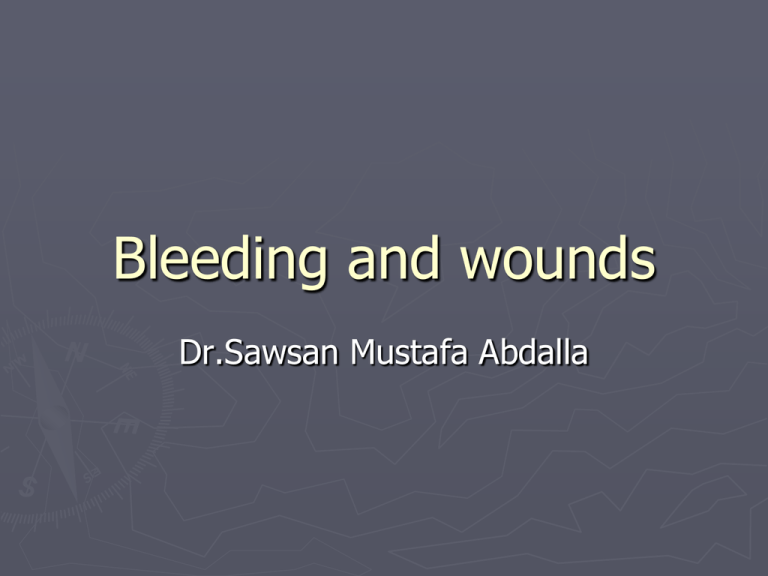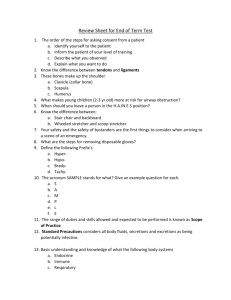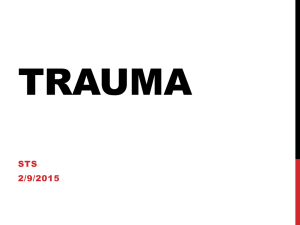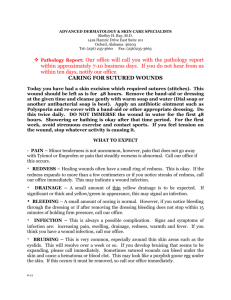Bleeding and wounds Dr.Sawsan Mustafa Abdalla
advertisement

Bleeding and wounds Dr.Sawsan Mustafa Abdalla Basic Trauma First thing first ► Remember ABC ► Airway If you stop moving air, nothing else matters. ► Breathing Stop breathing and it does not matter how much you bleed. You still die very quickly. ► Circulation You need blood and a functioning heart for this. Management of bleeding ► Stop the bleeding and protect the wound. If you remember this, that’s pretty much all you need to know. ► You may be called upon your skills for yourself or anyone else. Stop, Think, then Do! ► Remember to keep your cool! ► Medical injuries can be really ugly looking. ► Even the worst looking injuries can be survived. ► Don’t let the patient see you lose your cool. Bleeding and shock ► Shock Inadequate perfusion (blood flow) leading to inadequate oxygen delivery to tissues ► Most common cause of shock in the tactical environment is BLEEDING! Perfusion ► Basic unit of life = cell ► Cells get energy needed to stay alive by reacting oxygen with fuel (usually glucose) ► No oxygen, no energy ► No energy, no life Perfusion ► Cardiovascular System Transports oxygen, fuel to cells Removes carbon dioxide, waste products for elimination from body Cardiovascular system must be able to maintain sufficient flow through capillary beds to meet cell’s oxygen and fuel needs Flow = Perfusion Adequate Flow = Adequate Perfusion Inadequate Flow = Indequate Perfusion (Hypoperfusion) Hypoperfusion = Shock Basic Plumbing ► Pump ► Pipes ► Fluid ► Any Heart Blood Vessels Blood interruption leads to low blood flow (hypoperfusion) and shock. Bleeding ► Bleeding (hemorrhage) is the escape of blood from capillaries, veins, and arteries. ► Capillaries are very small blood vessels that carry blood to all parts of the body. ► Veins are blood vessels that carry blood to the heart. ► Arteries are large blood vessels that carry blood away from the heart. ► Bleeding can occur inside the body (internal), outside the body (external) or both. Bleeding ► There are three types of bleeding. Capillary bleeding is slow, the blood "oozes" from the (wound) cut. Venous bleeding is dark red or maroon, the blood flows in a steady stream. Arterial bleeding is bright red, the blood "spurts" from the wound. ► Arterial bleeding is life threatening and difficult to control. Small wounds ► In small wounds, only the capillaries are damaged. ► Deeper wounds result in damage to the veins and arteries. ► Damage to the capillaries is usually not serious and can easily be controlled with a Band-Aid. ► Damage to the veins and arteries are more serious and can be life threatening. Larger Wounds ► The adult body contains approximately 5 to 6 quarts of blood (10 to 12 pints). ► The body can normally lose 1 pint of blood (usual amount given by donors) without harmful effects. ► A loss of 2 pints may cause shock, a loss of 5 to 6 pints usually results in death. ► During certain situations it will be difficult to decide whether the bleeding is arterial or venous. The distinction is not important. ► The most important thing to remember is that all bleeding must be controlled as soon as possible. External Wounds ► While administering first aid to a casualty who is bleeding, you must remain calm. ► The sight of blood is an emotional event for many, and it often appears severe. ► However, most bleeding is less severe than it appears. ► Most of the major arteries are deep and well protected by tissue and bone. ► Although bleeding can be fatal, you will usually have enough time to think and act calmly. Take Control ► There are four methods to control bleeding: Direct pressure Elevation Indirect pressure Use of a tourniquet. Direct pressure ► Direct pressure is the first and most effective method to control bleeding. ► In many cases, bleeding can be controlled by applying pressure directly to the wound. ► Direct pressure can be applied by the casualty or a bystander. ► Under no circumstances is a dressing removed once it has been applied. Indirect pressure ► In cases of severe bleeding when direct pressure and elevation are not controlling the bleeding, indirect pressure must be used. ► Bleeding from an artery can be controlled by applying pressure to the appropriate pressure point. ► Pressure points are areas of the body where the blood flow can be controlled by pressing the artery against an underlying bone. ► Pressure is applied with the fingers, thumb, or heel of the hand. Signs of internal bleeding ► 1. Anxiety and restlessness. ► 2. Excessive thirst (polydipsia). ► 3. Nausea and vomiting. ► 4. Cool, moist, and pale skin (cold and clammy). ► 5. Rapid breathing (tachypnea). ► 6. Rapid, weak pulse (tachycardia). ► 7. Bruising or discoloration at site of injury (contusion). Basic wound care ► In evaluating the casualty for location, type, and size of the wound or injury, cut or tear his clothing and carefully expose the entire area of the wound. This procedure is necessary to avoid further contamination. Clothing stuck to the wound should be left in place to avoid further injury. DO NOT touch the wound; keep it as clean as possible. ► DO NOT REMOVE protective clothing in a chemical environment. Apply dressings over the protective clothing. Basic Penetrating Trauma ► Before applying the dressing, carefully examine the casualty to determine if there is more than one wound. ► A missile may have entered at one point and exited at another point. ► The EXIT wound is usually LARGER than the entrance wound. Basic Penetrating Trauma ► Casualty should be continually monitored for development of conditions which may require the performance of necessary basic lifesaving measures, such as clearing the airway and mouth-to-mouth resuscitation. ► All open (or penetrating) wounds should be checked for a point of entry and exit and treated accordingly. Basic Penetrating Trauma Basic Penetrating Trauma ► ► ► ► ► If the missile lodges in the body (fails to exit), DO NOT attempt to remove it or probe the wound. Apply a dressing. If there is an object extending from (impaled in) the wound, DO NOT remove the object. Apply a dressing around the object and use additional improvised bulky materials/dressings (use the cleanest material available) to build up the area around the object. Apply a supporting bandage over the bulky materials to hold them in place. Battlefield dressing ► DO NOT touch the white (sterile) side of the dressing, and DO NOT allow the white (sterile) side of the dressing to come in contact with any surface other than the wound. Battlefield dressing ► Hold the dressing directly over the wound with the white side down. ► Pull the dressing open and place it directly over the wound Battlefield dressing ► ► ► ► Hold the dressing in place with one hand. Use the other hand to wrap one of the tails around the injured part, covering about one-half of the dressing. Leave enough of the tail for a knot. If the casualty is able, he may assist by holding the dressing in place. Battlefield dressing ► ► ► If bleeding continues after applying the sterile field dressing, direct manual pressure may be used to help control bleeding. Apply such pressure by placing a hand on the dressing and exerting firm pressure for 5 to 10 minutes. The casualty may be asked to do this himself if he is conscious and can follow instructions. Battlefield dressing ► ► ► ► Elevate an injured limb slightly above the level of the heart to reduce the bleeding. DO NOT elevate a suspected fractured limb unless it has been properly splinted. If the bleeding stops, check and treat for shock. If the bleeding continues, apply a pressure dressing. Your Battlefield dressing ► The Israeli dressing ► One dressing does it all Simple dressing Pressure dressing Tourniquet Your Dressing ► ► ► The sterile, non-adherent pad is placed on the wound. The application of direct pressure to the wound site is achieved by wrapping the elasticized woven leader over the topside of the bandage pad where the specially designed pressure bar is situated. The pressure bar is designed to readily accept the wrapping leader. After engagement of the pressure bar, wrapping the leader in any direction around the limb or body part and onto the pressure bar forces the pressure bar down onto the pad creating the direct pressure needed to bring about homeostasis. Your Dressing ► The pressure bar, in addition to its primary function, facilitates bandaging. The elastic bandage uses the rigid shape of the pressure bar to change direction while bandaging, thus affording the caregiver more options for effective dressing of the wound. ► Subsequent wrappings of the leader secures and maintains the pad in place over the wound, and by covering all the edges of the pad acts as a sterile secondary dressing. The bandage leader is woven wide and will not bunch up or twist itself into a rope. Your Dressing ► The closure system of the bandage is multifunctional yet simple, quick, and familiar. Situated at the end of the leader is a closure bar (dowel with hooking clips) at each end to secure the wrapping leader the same way that a pen is secured in a shirt pocket. The closure bar holds the bandage securely in place over the wound site. Your Dressing ► If additional pressure is required the closure bar is easily removed from its normal closure position and inserted between previous layers of the leader directly above the protruding pressure bar and rotated. This rotation acts to screw down the pressure bar onto the wound to exert blood-staunching pressure. The closure bar is used as before to secure the dressing Your Dressing ► Immediate and effective direct pressure to the wound may reduce the need for a tourniquet application. This is an important benefit as tourniquet applications are to be avoided and used only as a last resort. Thanks for your attention.





